Design Practice II
Final Research Question:
How might prioritising level design in game development, as the central core influencer of the other aspects of production (such as narrative, character development, and mechanics), act as an alternate means of enhancing the player’s immersive and interactive gameplay experience?
Note: In week 4 (5/26/23) I have modified the final version of my research question. I believe it is a research question that can be applied to all weekly tests, but please keep in mind that this is an improved research question from week 4 and I did not think of this research question in weeks 1-3. Therefore, there may be some discrepancies between the descriptions of ingredients and works produced during this period and the final version of the research.
Week1 - Raiding the Pantry
Research Question Week 1:
How might designers approach narratives, and guidance in a third-person adventure gaming environment to enhance the immersive and interactive gameplay experience with the game players through level design?
Raw
Food: not cooked
Materials: [usually before noun] in its natural state; not yet changed, used or made into something else
Information: not yet organized into a form in
which it can be easily used or understood
emotions/qualities: powerful and natural; not trained or showing
control
part of body: red and painful because the skin has been damaged
Person: new to a job or
an activity and therefore without experience or skill
Weather: very cold
Description: honest, direct and sometimes
shocking
Research Question Week2:
How might designers approach narratives, and guidance in a third-person adventure gaming environment to enhance the immersive and interactive gameplay experience with the game players through level design?
Processed
Food: to treat raw material, food, etc. in order to change it, preserve it, etc.
Item: process something to deal officially with a document, request, etc.
Computer: process something (computing) to perform a series of operations on data in a computer
Communication: to understand the meaning of something that has happened or been said
Readymade
- Prepared in advance so that you can eat or use it immediately.
- Already provided for you so you do not need to produce or think about it yourself
Clothes: made in standard sizes, not to the measurements of a particular customer already provided for you so you do not need to produce or think about it yourself
Standardised
standardize something to make objects or activities of the same type have the same features or qualities; to make something standard
Hot
- having a high temperature; producing heat
- (of a person)feeling heat in an unpleasant or uncomfortable way
- making you feel hot
- containing pepper and spicesthat can produce a burning feeling in your mouth because they have a strong taste and smell
- involving a lot of activity, argument or strong feelings
- difficult or dangerous to deal with and making you feel worried or uncomfortable
- new, exciting and very popular
- fresh, very recent and usually exciting
- likely to be successful
- hot at/on something (informal) very good at doing something; knowing a lot about something
- if somebody has a hot temperthey become angry very easily
- feeling or causing sexual excitement
- containing scenes, statements, etc. that are of an extreme nature and are likely to shock or anger people
- hot on somethingthinking that something is very important and making sure that it always happens or is done
- of music, especially jazz)having a strong and exciting rhythm
- stolen and difficult to get rid of because they can easily be recognized
- used in children’s games to say that the person playing is very close to finding a person or thing, or to guessing the correct answer
Cold
- having a lower than usual temperature; having a temperature lower than the human body
- not heated; cooled after being cooked
- without emotion; not friendly
- seeming to lack any warm feeling, in an unpleasant way
- not easy to find
- (Game)used in children’s games to say that the person playing is not close to finding a person or thing, or to guessing the correct answer
- out cold
- the cold facts/truth
Porous
having many small holes that allow water or air to pass through slowly
Desiccated
- (of food)dried in order to preserve it
- completely dry
Solid
- hard; not in the form of a liquid or gas
- having no holes or spaces inside; not hollow
- (of a line)without spaces; continuous
- made completely of the material mentioned (that is, the material is not only on the surface)
- strong and made well
- that you can rely on; having a strong basis
- definitely good and steady but perhaps not excellent or special
- without a break; continuous
- of the colour mentioned and no other colour
- (geometry)a shape that is solid has length, width and height and is not flat
- in complete agreement; agreed on by everyone
Sticky
- made of or covered in a substance that sticks to things that touch it
- (of paper, labels, etc.)with glue (= a sticky substance) on one side so that you can stick it to a surface
- (informal)(of the weather) hot and slightly wet
- (of a person)feeling hot and uncomfortable
- difficult or unpleasant
- (of a website) so interesting and well organized that the people who visit it stay there for a long time
Fermented
To experience a chemical change because of the action of yeast or bacteria, often changing sugar to alcohol; to make something change in this way
Word Matrix
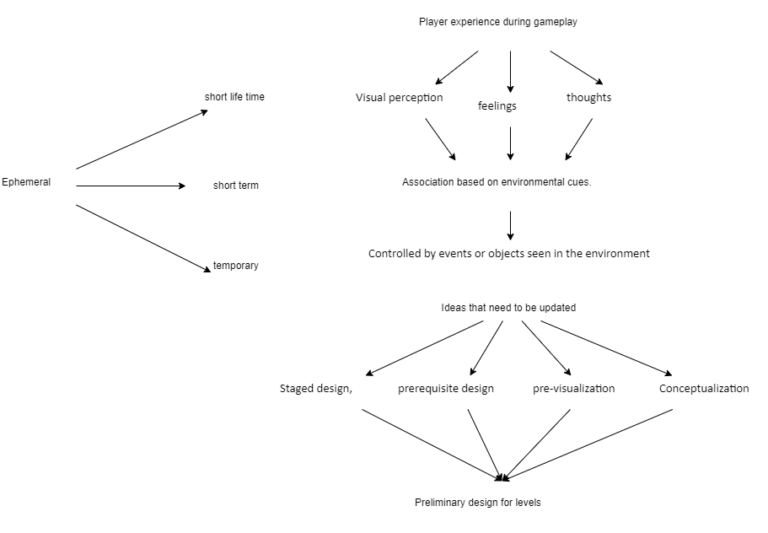
Ephemeral describes how both pre-visualization and conceptualization are temporary stages in the whole-level design process, and further design is required during the production phase. In my practice, I can design levels in these two stages to test various possibilities.
The emotions that the environment evokes in players during gameplay are also temporary in nature, they are influenced by events, objects within the environment, and associations based on the surroundings.
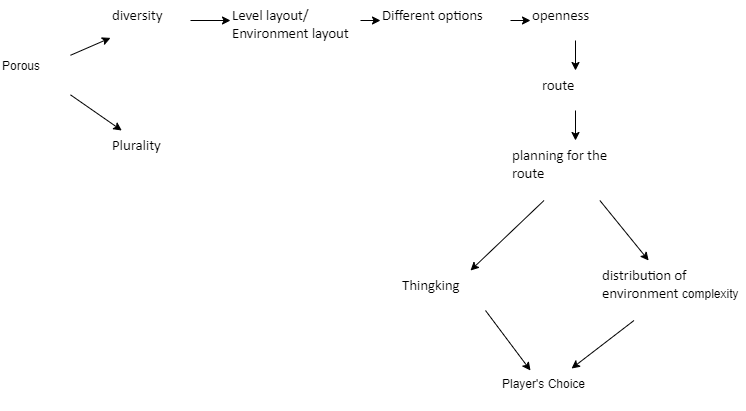
The word ‘porous’ reminds me of the diversity of the environment. In a complex game environment, players must carefully observe their surroundings and strategically plan their actions, which requires them to think throughout the gameplay process.
Therefore, this word corresponds to multi-path level designs that can stimulate players’ thinking.
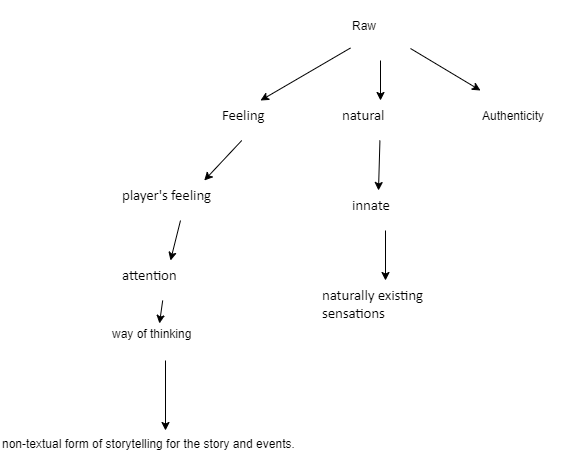
Raw
For me, Raw can be seen as a design element or something that needs to be considered during the design process. I use raw elements to create a natural and authentic environment for the audience. When interacting with the game, players naturally immerse themselves in the character they control, creating what is known as immersion. However, the big head of creating the immersion is not only by controlling the character, in fact the environment player’s character stay in is the mean part of creating immersion.
Creating levels using design language people familiar with and natural is an important factor in immersing players. The environment within the level needs to match the game’s theme and adhere to our real-life design language, preventing players from feeling a sense of uncanniness due to differences between the environmental design and what they’re used to in real life. This helps maintain immersion for players throughout gameplay. Of course, in game design, it is possible to intentionally create such a sense of strangeness to achieve certain design aims. However, one of my aims is to use level design to create immersion, so reverse using the raw is not something that I need to be concern about at this stage.
Level layout Drawings: Ephemeral, Porous, Raw
As the beginning of this long-term experiment for DP2, I decided to start with drawing. Based on my research question, my paradigm is level design can be seen as the core of game design, using levels as a method for designing narrative and guidance in order to create an immersive and interactive experience for players. So, I experimented the medium of creative experience by drawing the levels. The level layout is a stage in the level design pipeline and it is an extremely important stage in the level design pipeline. It converts the designer’s ideas for creating levels into a sketch from a top-down perspective. Large and complex level layouts look like sponges, which is why I associate them with “Porous”.
Level layout is the first version of a level that game designers create (most, some designer have their own creation pipeline). It allows others to understand what the designer has in their mind, including the most basic design elements, and provides feedback while preparing for the creation inside game engine. I place this method within conceptualization method because it corresponds perfectly with the ephemeral nature of level layouts, which are destined to be discarded and ultimately appear in playable form within a game.
Because of working and daily study, I haven’t been designing levels for a long time since completing my undergraduate studies (after last year). My design skills may inevitably decline and become unfamiliar. So I decided to gradually awaken my memory and feeling for level design from simple to more complex designs. This is also my way of progressing from designing levels that take 5 minutes to those that take 30 minutes.

Maze:
My design idea is a simple maze without any rich story or complex terrain, I didn’t consider about how “raw” can be use in production. It was just a map with simple interactivity. Interestingly, this experiment made me realize a feature that should have been discovered when designing or planning to design but had not been discovered yet – the natural interactivity of mazes as an existing “toy”. Because the maze is meant to have people decipher it and it has inherent characteristics of toys and games, no matter what medium it appears in (such as paper, video games, real maze building), it always carries the element of “play”, which is also another element for creating experiences.
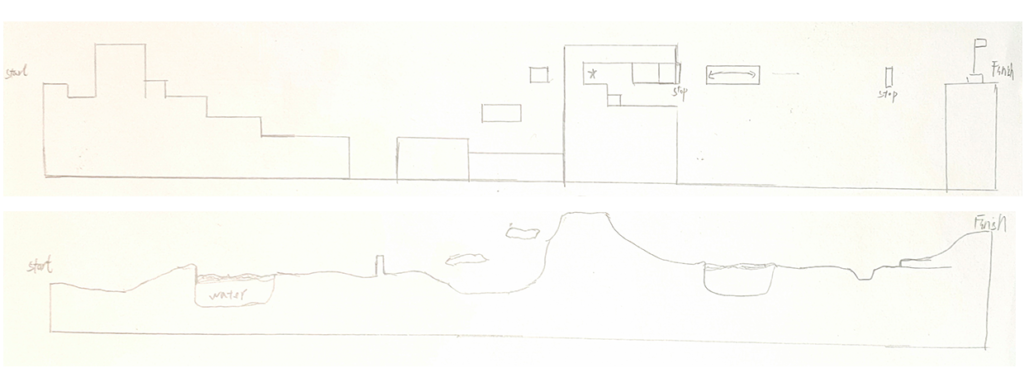
Platform:
After designing several mazes, I decided to switch to a 2D side-scrolling platformer. Following the narrative structure of “起承转合” in Super Mario 3D World, I created two levels that gradually increase in difficulty and help players improve their movement skills.
起承转合:
“Introduce, develop, twist, conclusion” is a traditional Chinese narrative style represented by four characters. In game design, it can be used to introduce levels or skills that players will learn. Develop has been used to complex levels, challenging players to exercise their skills. Twist has been using as the more complex level that has added other extra elements that the player has experienced before. Finally, the conclusion is just the end of the level.
More information can be found in this video: (8) Super Mario 3D World’s 4 Step Level Design – YouTube
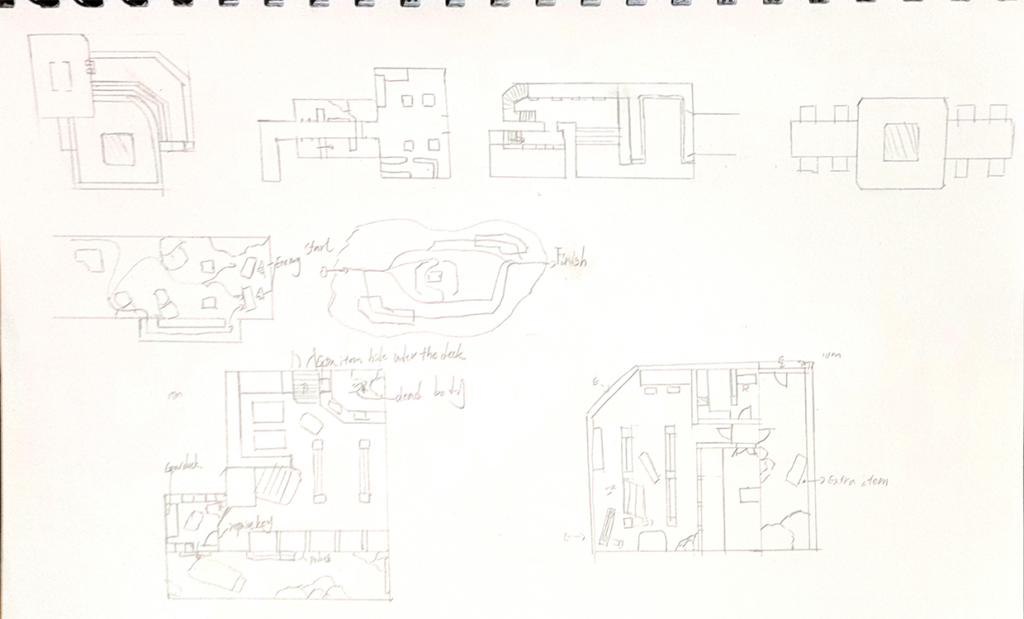
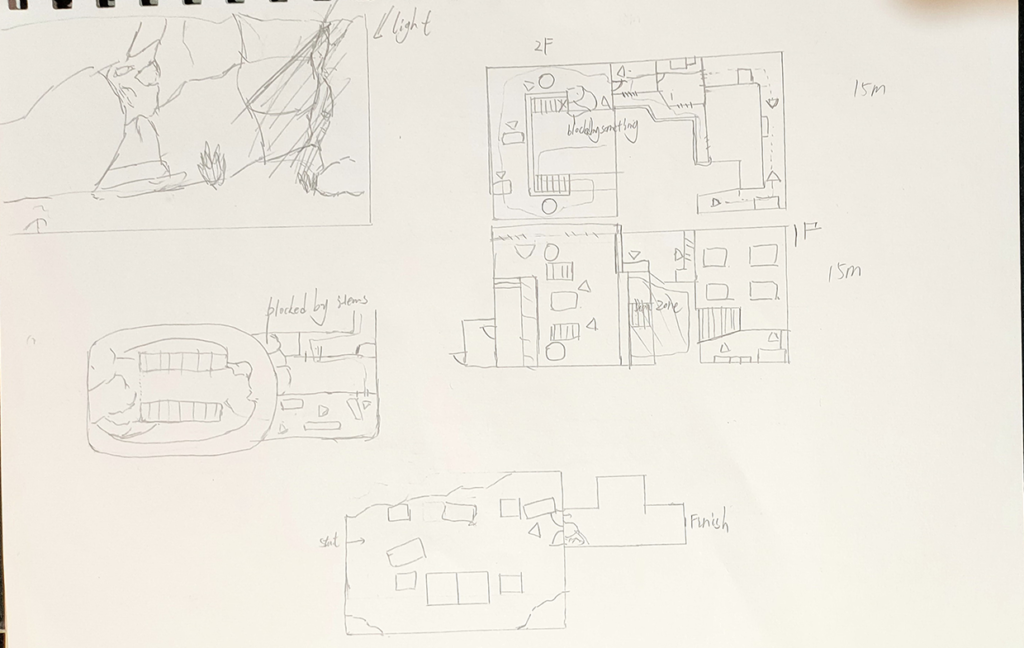
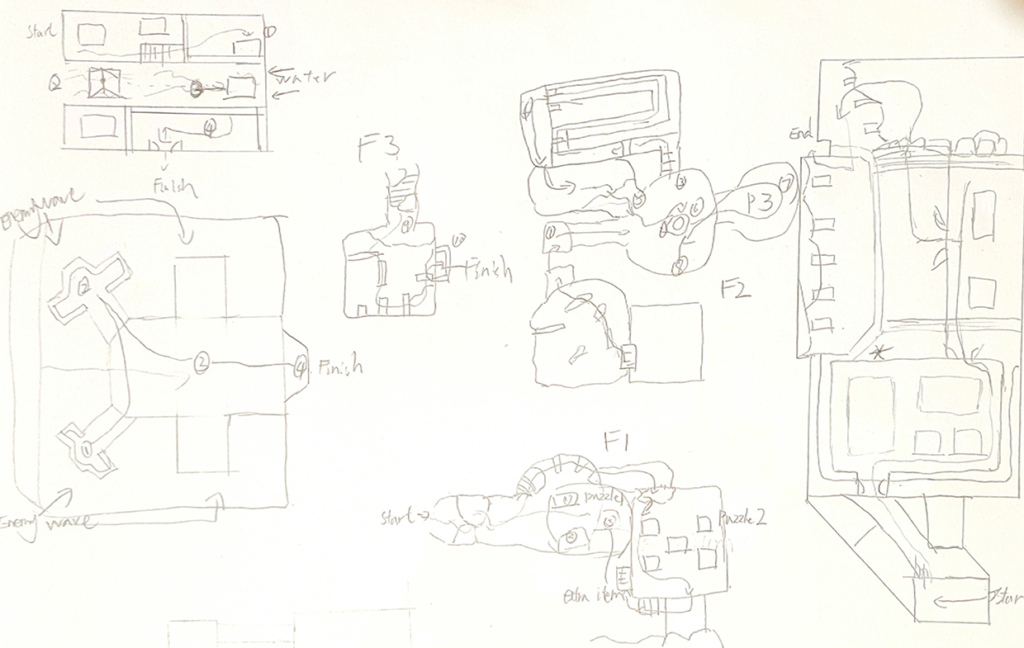
Scenes, environment, buildings:
After completing the warm-up, I began to incorporate the “raw “ingredient into the artfeact. At this stage, I started considering the rationality of the area or environment that I was designing and planned out possible routes for players within each level, which involved player guidance. For example, how to place cover in a scene or the direction of a wall – these natural directions within a scene will guide players towards their next objective. As production time increased, later-level layouts became increasingly complex.
3 One Hour Work
For that one-hour artifact, I created two environments and a grey box based on my designed level. Both scenes were created based on the research question’s narrative and immersion keywords, incorporating three ingredients into the creation process. The purpose of this experiment was to practice creating game scenes using the keyword “raw” to become familiar with how to create non-strange scenes; and to try introducing narrative elements into the environment to tell a story. The grey box is an extension of the previously created level layout. The levels are rebuilt using simple cubes, but due to the frequent distortion of proportions during the drawing process of level layout, the levels will also be reconstructed during the grey box process. At the same time, a grey box was also used in the production process of both environments.
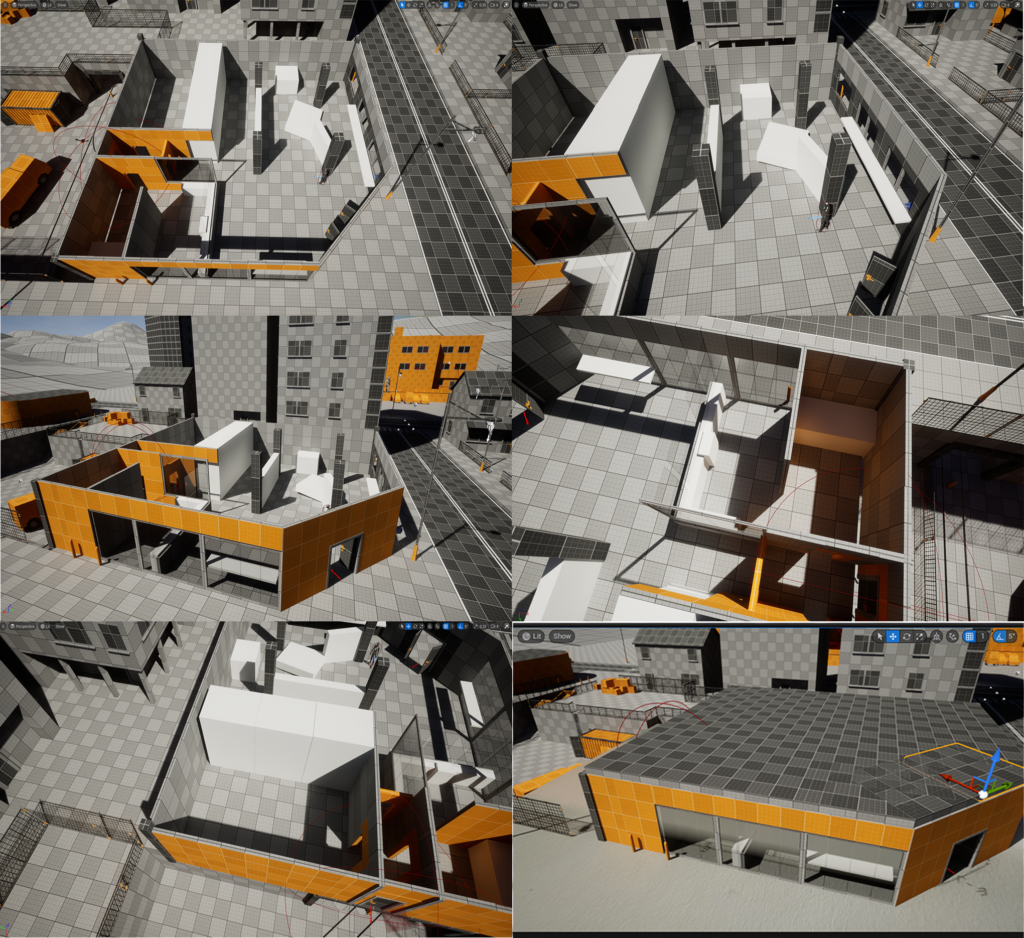
Greybox:
This project is an expanded version of a previous one, which has been transformed into 3D and adjusted to fit the level design in Unreal Engine.
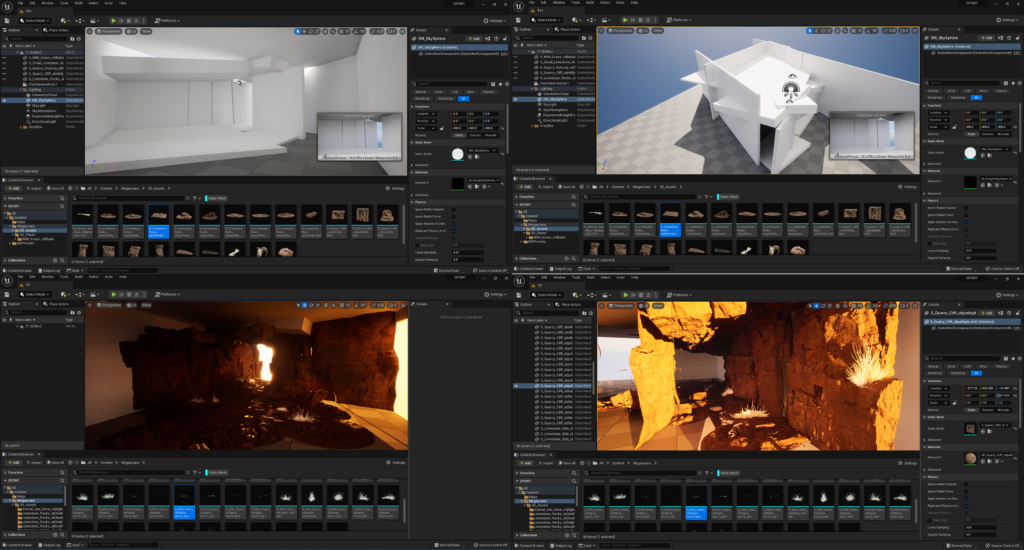
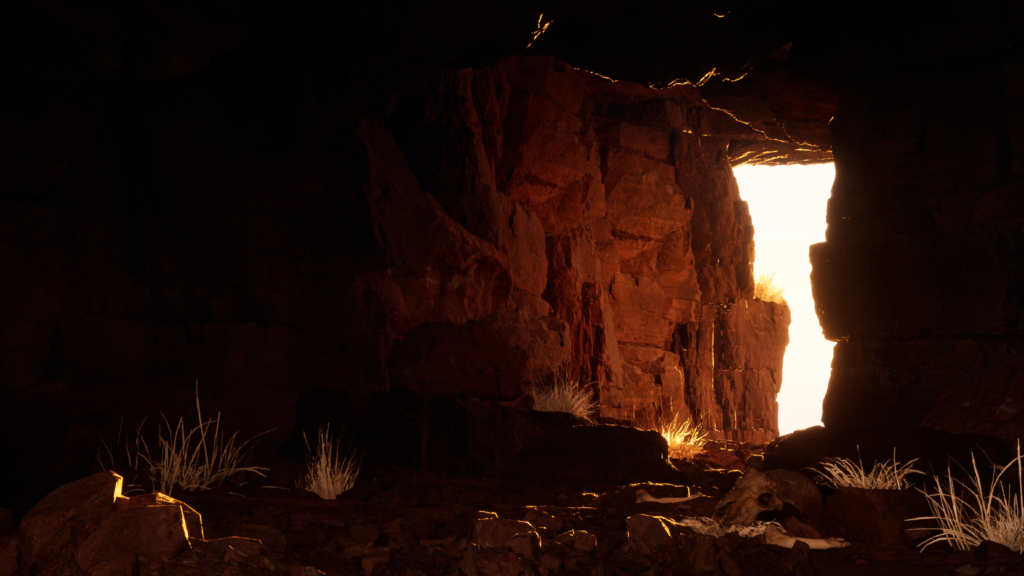
The Design is made by me, but resources used for the production are sourced from the Quixel a free asset library for Unreal game engine.
Desert:
Just as its name, this is a desert environment during the twilight hours. The theme of this environment is desolation and stillness. Within the vast cave, there are only displays of withered grass and animal skulls devoid of any signs of life. As design elements, they convey to the audience a sense of desolation and stillness.

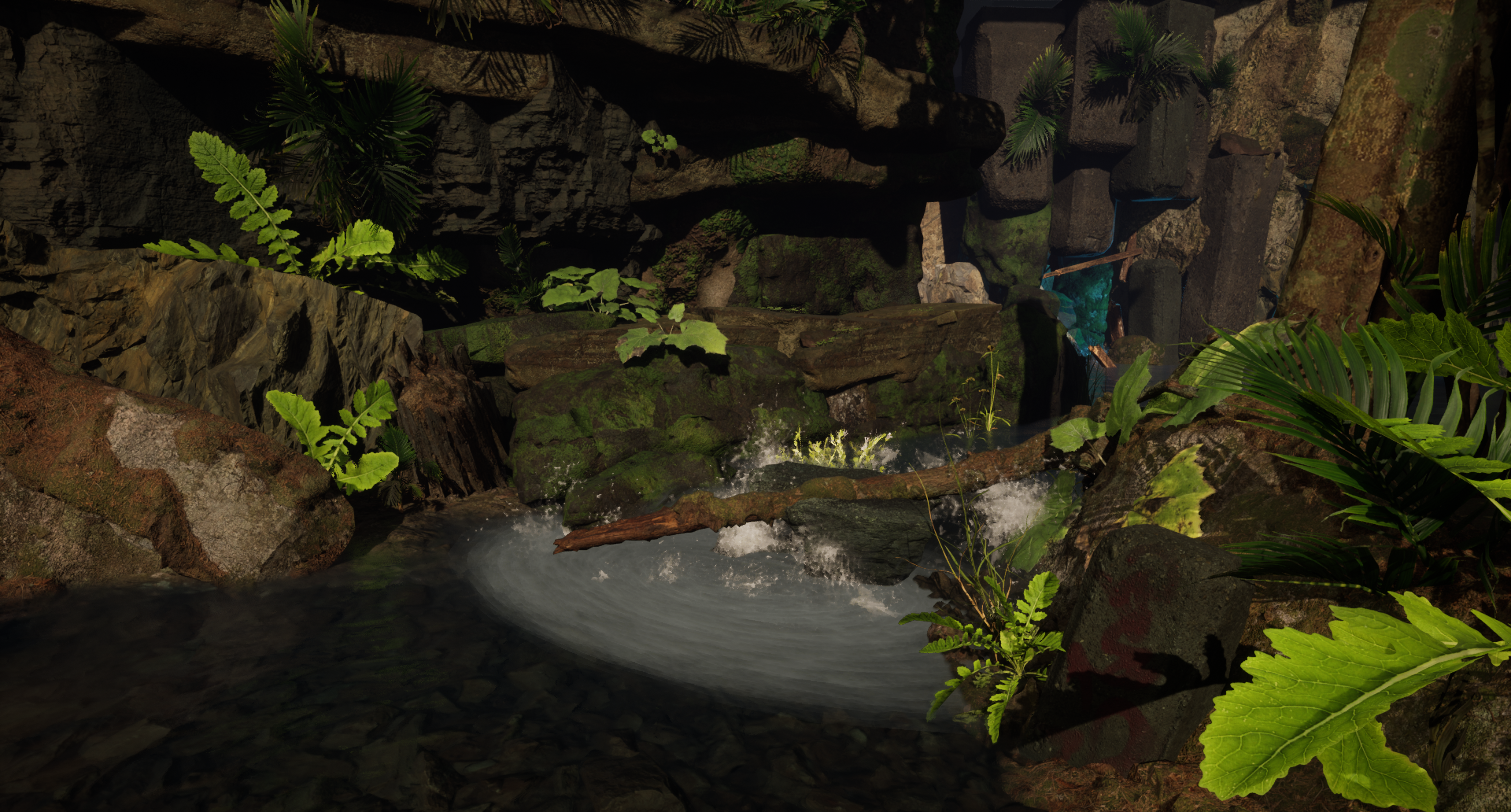
The Design is made by me, but resources used for the production are sourced from the Quixel a free asset library for Unreal game engine.
Rainforest:
The rainforest environment aims to express a sense of mystery, as if there may be magic or fantastical items hidden deep within the cave. My creative idea is to focus on a cave emitting strange light, attracting the attention of adventurers who come here.
Due to the cancellation of week 2 classes caused by heavy rain, there were no comments or questions from peers in my work.
DP2 6 weeks draft plan and what to do after week 1’s making:
Since the final project of my research will be presented using a video game, and I have already selected the game engine for the production stage, conducting material testing is no longer necessary. The methods used in the DP2 experiments will be closely related to the design methods and methodology I will employ. Throughout the 6-week experiment period, I will consistently follow an iterative design methodology1, cycling through the level design-making pipeline2. Various making ingredients (Keywords) will be incorporated into the process to explore and test different design methods and techniques.
Week 1 Reflection:
During the first week, I found myself drawn to the ingredients Ephemeral, Porous, and Raw as they evoked elements within the level design and the creative process. Since material testing was not necessary, my experiments during this week were focused and purposeful. I diligently followed the level design process, working on various stages of level design to meet specific artistic requirements within designated timeframes.
Ephemeral reminding me of the time-sensitive tasks involved in the pre-production, layout, and blackout stages of the level design pipeline. These stages, much like Ephemeral itself, it is temporary and contribute to the preparation of a final work. Porous triggered my thoughts on creating 2D maps for game levels, which straight-up connect to the layout stage from the level design pipeline. The experiment conducted using Raw focused on creating authentic levels to ensure that players do not feel a sense of unfamiliarity while playing, aligning with their common sense in daily life. Additionally, the experiment also involved testing how to use environment storytelling to tell the player a story by walking around the level.
Week2 - Cooking with Gas
Research Question Week2:
How might designers approach narratives, and guidance in a third-person adventure gaming environment to enhance the immersive and interactive gameplay experience with the game players through level design?
1. Word Definitions
Delaminate:
verb (used without object), de·lam·i·nat·ed, de·lam·i·nat·ing.
- to split into laminae or thin layers.
Reconstitute:
verb (used with object), re·con·sti·tut·ed, re·con·sti·tut·ing.
- to constituteagain; reconstruct; recompose.
- to return (a dehydrated or concentrated food or other substance) to the liquid state by adding water:to reconstitute a bouillon cube with hot water.
- to undergo reconstitution; become reconstituted.
Layer:
Noun:
- A layerof a material or substance is a quantity or piece of it that covers a surface or that is between two other things.
- If something such as a system or an ideahas many layers, it has many different levels or parts.
verb:
- If you layersomething, you arrange it in layers.
Dissolve:
verb (used with object), dis·solved, dis·solv·ing.
- to make a solution of, as by mixing with a liquid; pass into solution:to dissolve salt in water.
- to melt; liquefy: to dissolve sugar into syrup.
- to undo (a tie or bond); break up (a connection, union, etc.).
Aerate:
verb (used with object), aer·at·ed, aer·at·ing.
- to expose to the action or effect of airor to cause air to circulate through.
- to change or treat with air or a gas, especially with carbon dioxide.
- to expose (a medium or tissue) to air as in the oxygenation of the blood in respiration.
Eviscerate:
verb (used with object), e·vis·cer·at·ed, e·vis·cer·at·ing.
- to remove the entrails from; disembowel
- to deprive of vital or essential parts
- to remove the contents of (a body organ).
Glaze:
Noun, glazed, glaz·ing.
- A glazeis a thin layer of liquid which is put on a piece of pottery and becomes hard and shiny when the pottery is heated in a very hot oven.
- A glazeis a thin layer of beaten egg, milk, or other liquid that you spread onto food in order to make the surface shine and look attractive.
verb (used with object)
- When you glazefood such as bread or pastry, you spread a layer of beaten egg, milk, or other liquid onto it before you cook it in order to make its surface shine and look attractive.
Amalgamate:
verb (used with object), a·mal·ga·mat·ed, a·mal·ga·mat·ing.
- to mix or merge so as to make a combination; blend; unite; combine
- to mix or alloy (a metal) with mercury.
- to combine, unite, merge, or coalesce
- to blend with another metal, as mercury.
Substitute
noun, sub·sti·tut·ed, sub·sti·tut·ing.
- a person or thing acting or serving in place of another.
- (formerly) a person who, for payment, served in an army or navy in the place of a conscript.
- a word that functions as a replacement for any member of a class of words or constructions, as do in He doesn’t know but I do.
verb (used with object)
- to put (a person or thing) in the place of another.
- to take the place of; replace.
verb (used without object)
- to act as a substitute.
Subtract:
verb (used with object)
- to withdraw or take away, as a part from a whole.
- to take (one number or quantity) from another; deduct.
verb (used without object)
- to take away something or a part, as from a whole.
Morselate:
- Bite and chew into pieces
2. Key terms from the Week1 experiment:
Iterative Design Methodology
3. Ingredients:
Eviscerate:
Through the process of “Eviscerate,” I aim to ‘Eviscerate’ exceptional environment designs, level designs, and games. By ‘Eviscerating’ these works, I can understand their intricacies and reproduce them in my own unique way. This reverse engineering approach allows me to grasp the level design elements embedded within the eviscerated work and gain a deeper understanding of their construction.
Glaze:
The word “Glaze” evokes the process of polishing or modifying a pre-existing design, which I believe is part of iterative design. During my free time last week, I shared my level design and environment design with friends to gather feedback and evaluate my work. With the concept of glaze, I aim to refine and enhance the designs I previously created, making them even better base on the evaluation made by last week.
Amalgamate:
In 3D modelling, software, using “Amalgamate “ to rapidly creation of basic shapes such as cubes and cylinders, serving as a foundation for upcoming building designs. This initial stage prepares the model for further refinement and detailing processes.
Week 2 Works:
In the second week’s experiment, I dispersed the ingredients I obtained and turned them into creative methods and ways to gain inspiration that could be used in the creation process.
4 X 15 mins

Combination creation and model assembly: Amalgamate
I chose to use this method three times for 15 minutes each in order to create with randomness as the foundation design of a building using the shortest amount of time possible. Although the direct connection between this experiment and the research question is not very clear, it is a creative method that could be applied during the process of achieving the research question.
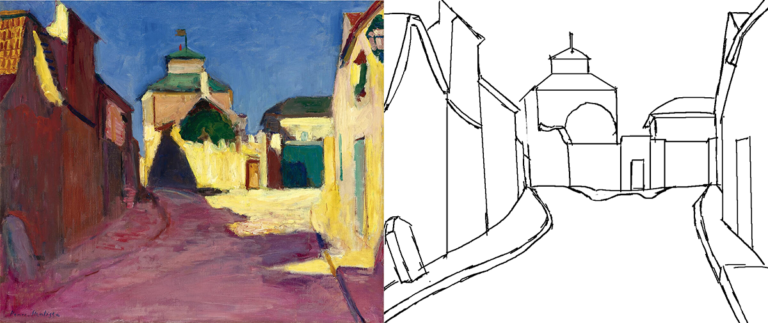
Recreate “Street in Arcueil”: Eviscerate
As I mentioned in my explanation of “Eviscerate”, the purpose of this exercise is to analyze and understand the design of existing works. The method I use is to reconstruct “Street in Arcueil”1 is lines, using lines to remove the blur of the oil painting and observing it through the most intuitive lines or geometric shapes composed of lines.
- Henri Matisse, Street in Arcueil, 1898, oil on canvas, France, Arcueil, Henri Matisse – Street in Arcueil, 1898 Oil on canvas, cm. 46 x 55. Private collection, New York | Katarte.
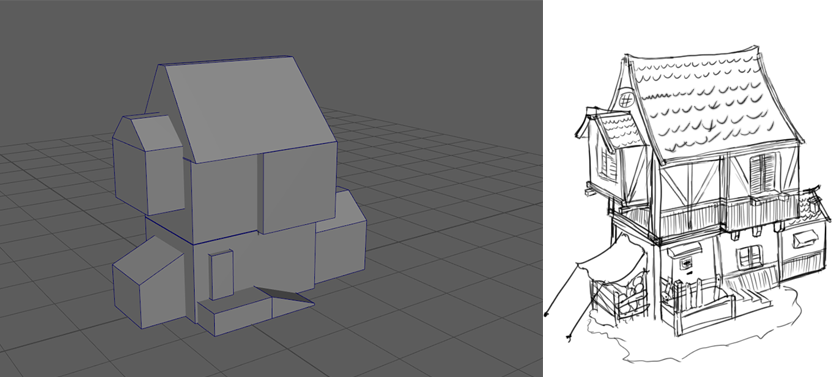
4 X 30 mins
Drawing on the Model: Amalgamate
After completing the model assembly experiment, I decided to further apply this method to demonstrate its complete use process as a design method. So I created a sketch of this house, a fantasy world cabin based on wooden frames and brick construction.
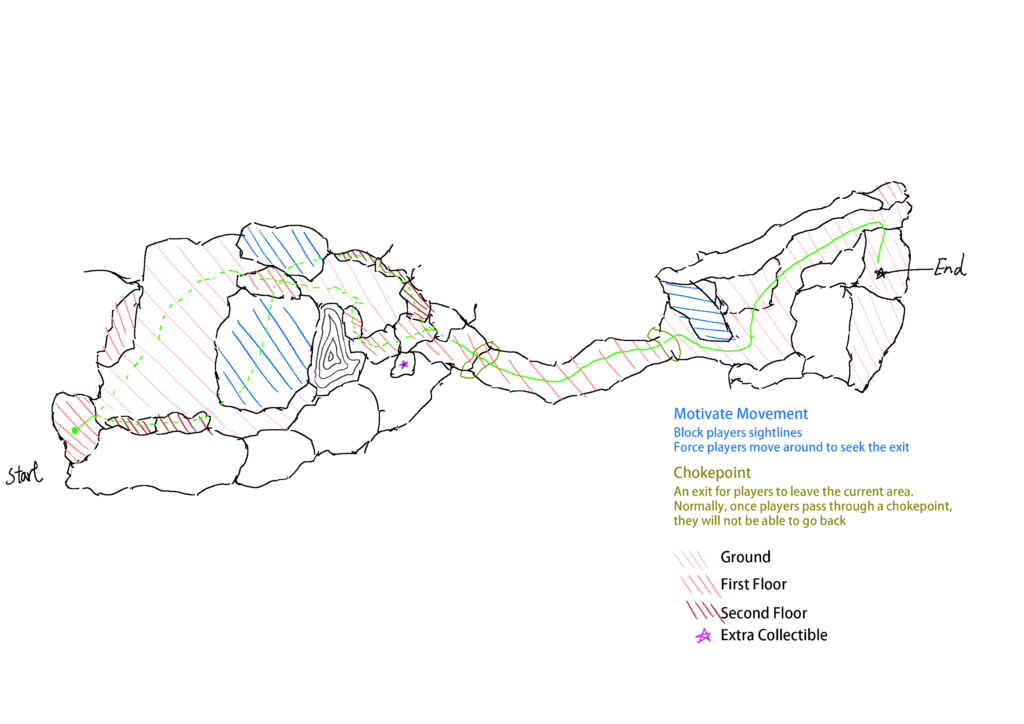
Expand level Design of Week 1, Step 1 : Glaze
I think the desert environment I created in week 1 was pretty good, so in the second week, I plan to expand it into a game level where players can play and experience narrative and guidance. As the first step of expansion design, based on the existing desert scene, I have redrawn the level layout (the far right is where the original environment set at). This experiment also shows that I am creating my own creative process or methodology because my creative process repeatedly uses level layout as the starting point for level design.
4 X 60 mins

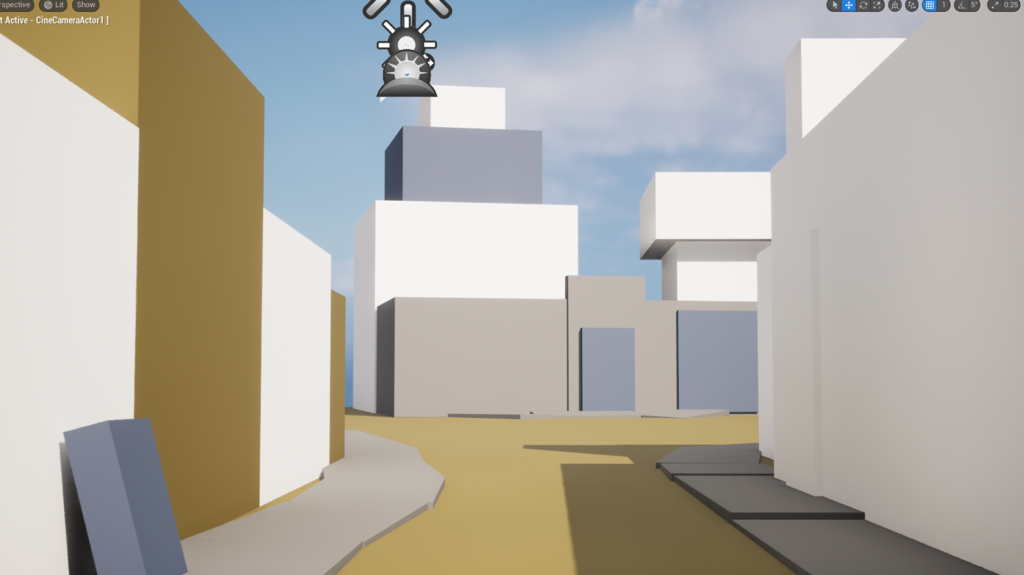

3D Recreate compare with original oil paint
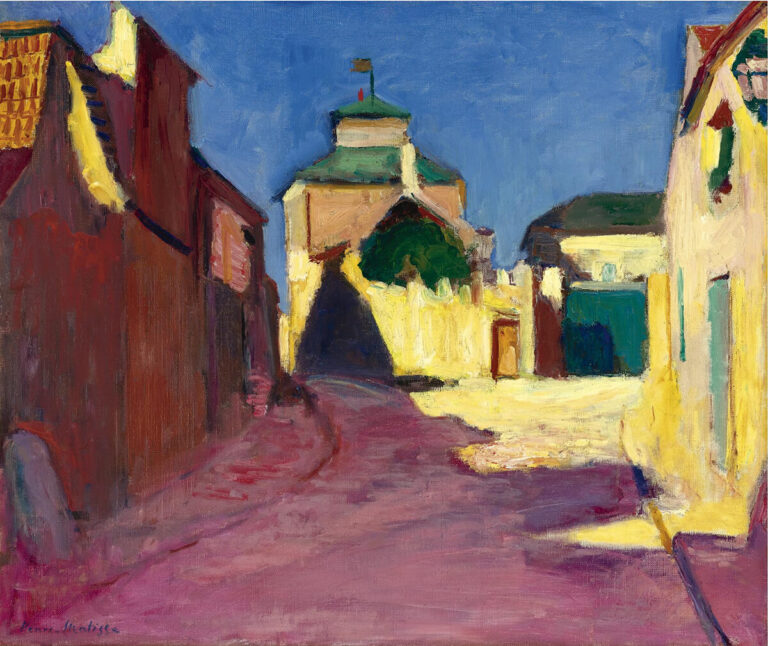
3D Recreate of “Street in Arcueil”: Eviscerate Amalgamate
After completing the experiment of recreating “Street in Arcueil” with lines, I decided to push this experiment further. I used a simple cube to replace the building and recreated it in 3D based on the line recreation, this is also a creation that has evolved the “Amalgamate”. Conducting this experiment helped me understand a specific way of guiding that is commonly used in a particular medium – painting, which I used for this project. Generally, drawings have a focal point that guides people’s eyes towards important information or what the author wants to express.
In the painting “Street in Arcueil”, I believe that the guiding element is the curved road in the picture, which leads the viewer’s gaze to a courtyard in the distance, where the main theme of the oil painting – a big house – is located. My 3D reconstruction has successfully reproduced this design element and also achieved my goal of analyzing and understanding it for future use in my own work.
Henri Matisse, Street in Arcueil, 1898, oil on canvas, France, Arcueil, Henri Matisse – Street in Arcueil, 1898 Oil on canvas, cm. 46 x 55. Private collection, New York | Katarte.
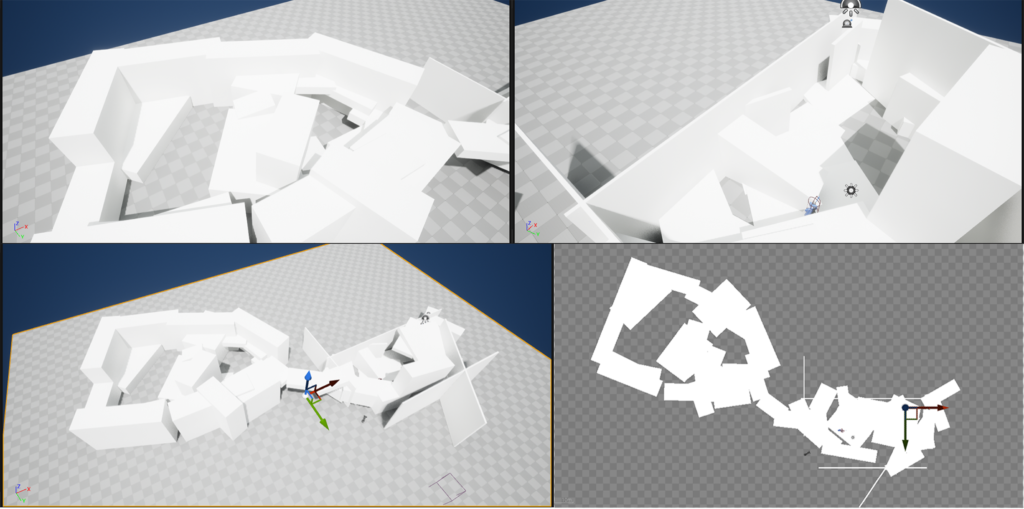
Expand level Design of Week 1, Step 2: Amalgamate, Glaze
As I mentioned in my explanation of “amalgamate”, the description of this ingredient made me associate it with the Grey box(Week 1‘s experiment) and integrate it together. After completing the level layout and marking out rough design elements as well as level’s height difference, I began using cubes to start block out the level for the first time, adjusting the environment’s size to better fit the character’s size. This process also shows that I am creating my own production method by 3D modelling levels after completing their layouts and making initial changes.
4 X 120 mins
Level Walk through Video

The level layout made in 30 mins
The Design is made by me, but resources used for the production are sourced from the Quixel a free asset library for Unreal game engine.
Expand level Design of Week 1, Step 3: Glaze
As the final step in the creative loop, there isn’t much to say about creating levels. It just takes time, and each area can be seen as 120 mins creation. It’s simply a matter of replacing the cubes in the level with pre-made models and making small adjustments to their placement angles based on how they fit into the level’s design, taking into account what players will see from different angles.
Week 2 Statement:
In order to explore how narrative and guidance can be achieved through level design in games, it is crucial to create and test with actual levels. Without hands-on design and testing, it is impossible to determine if players can have an immersive interactive experience during gameplay. Therefore, iterative design naturally became the methodology I employed in my creative process.
Throughout DP2’s experiments, iterative design acted as the core trunk, branching into three categories: conceptualization, prototype, and evaluation. The chosen ingredients for DP2’s course served as leaves on these branches.
During this stage, I utilized ingredients such as Ephemeral, Porous, Raw, Eviscerate, Glaze, and Amalgamate. These words were placed on different branches, with Ephemeral, Porous, Eviscerate, and Amalgamate categorised as conceptualization elements, while Raw and Glaze aligned with the purpose and behaviour of prototypes.
By employing these ingredients in a two-week iterative design process, I successfully developed a game level with guiding and narrative elements. I also explored new design methods for game buildings, which as the Amalgamate. However, the narrative side at my current level requires more work, as it currently lacks depth and meaning.
In the upcoming experiments, I will focus on environmental storytelling to achieve the goal of conveying stories within the game environment to players.
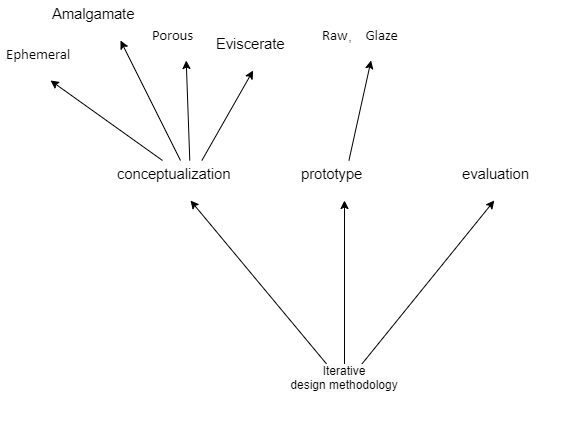
Week3 - Potluck Supper/ Progressive Dinner
Refelction for Week 2:
Due to the heavy rain causing the cancellation of the week 1 class, the second week’s class became a day to receive extensive feedback from both peers and lecturers. However, it also left me feeling confused once again. While reviewing my peers’ works and observing their creations, I found it challenging to distinguish between art and design. Many of the items lacked clear design elements, making it difficult for me to understand where design principles were applied and how designers achieved their desired effects. It appears that a significant number of my peers’ works lean towards being more artistic in nature. As a traditional designer, this situation has left me thoroughly perplexed.
During this week 2 feedback session, I encountered an awkward situation similar to DP1 where most people couldn’t understand what I was doing. This is probably due to the fact that we all come from different design and art backgrounds, with each of us having our own set of skills and ways of thinking. Consequently, it’s probably the reason why I ‘m thinking my peer’s work are lacking design elements.
Furthermore, I faced another predicament involving the presentation of my work and experimental creations to others. The challenge stems from the fact that my experiments revolve around the development of 3D environments, making it arduous to convey their essence through a 2D format for viewers. To address this issue, I attempted to compensate by recording walkthroughs, work-in-progress and overviews videos to interpret the intricacies of the environment I had crafted. Regrettably, these efforts appeared to have limited impact on the final outcome. It seems that the ideal solution would involve enabling viewers to interact with the environment directly, allowing them to fully grasp its design and essence.
While being the only student from the game design pathway this year means that I lack direct feedback and in-depth design discussions with peers, I have still found value in receiving feedback from other individuals. Meaningful feedback has been particularly valuable during my interactions with my lecturer. Through discussions about experiments and research questions, I have gained insightful perspectives. One specific focus was on an experiment involving the keyword “Eviscerate” and its significance. Initially, I did not consider this experiment to be of great importance. My perception was that reverse engineering primarily entailed learning, acquiring information, and drawing inspiration, with less emphasis on design elements, as it involved analyzing and recreating existing objects. However, my lecturer presented a different viewpoint. She believed that the process of reconstructing and applying design elements learned from artworks to one’s own work could already be seen as an act of designing. The development of a unique methodology for experimenting with Eviscerate has become a personal distinction for me. Furthermore, she suggested conducting more comprehensive experiments in the upcoming week, not limited to game or drawings, but expanding the analysis to other forms of artwork and design. I personally agree with this idea and plan to undertake such experiments next week, if possible.
Context (environment/ methodology):
Compose:
Follow the level design pipeline for creation, as well as use newly explored creative methods for production.
As a level designer, I incorporate my personal understanding and research results into designing game levels by integrating guiding elements and story elements from the environment, transforming them into visual elements to create an immersive “experience,” which in turn leads to high-quality level design
Follow the level design pipeline for the creation and employ newly explored creative methods.
As a level designer, I incorporate my personal understanding and research findings into the design of game levels. This involves integrating guiding elements and story elements from the environment and transforming them into visual elements that contribute to the creation of an immersive ‘experience.’ Ultimately, this approach results in high-quality level design.
Situation:
The creation I am working on needs to adhere to a design language familiar to people in the real world. This is important so that the audience can engage with it without feeling out of place or experiencing a sense of strangeness within the scene.
Distribution (impact/reach):
Participate:
The game exists on the computer or game console so it’s virtual in itself. The drawings I made during the preparation stage do not have a tangible quality for the audience to touch or feel, so my entire experiment is based on virtual elements.
Virtual:
Considering that games necessitate player engagement to generate experiences, my creation requires audience participation for the full experience. Items that require audience participation are usually high-quality products. During the early stages of design, audiences cannot participate in the creation process and interaction.
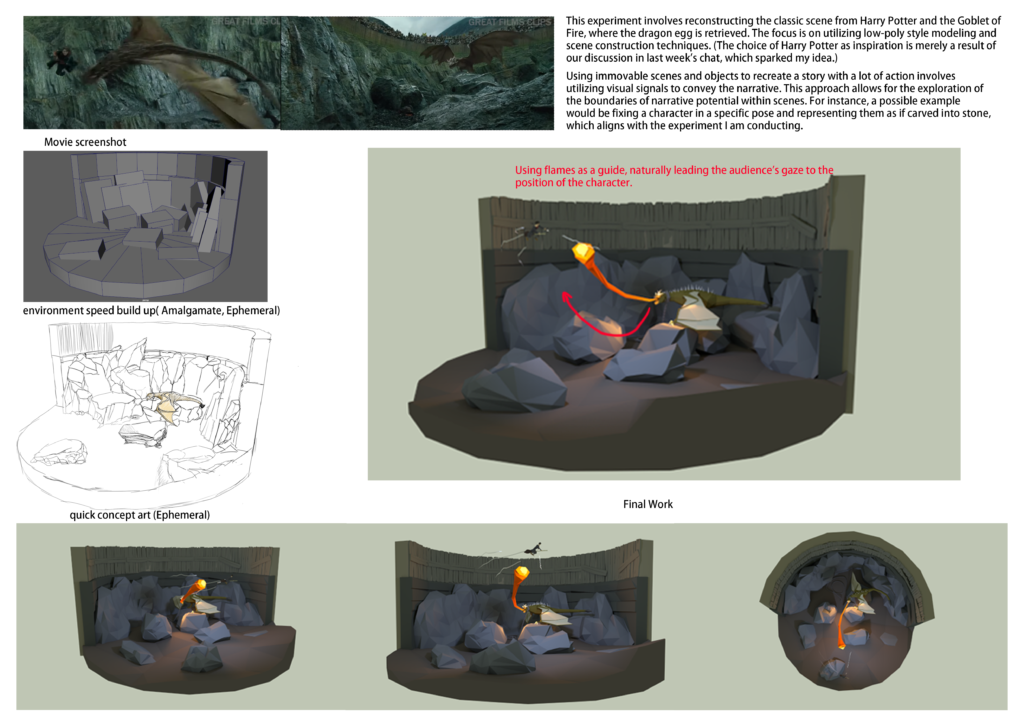
Made with Maya 3D Modeling software.
The experiment involves modeling and constructing the scene in low poly style to recreate the classic moment of retrieving the dragon egg from Harry Potter Goblet of Fire. (Choosing Harry Potter was simply because it came up in last week’s conversation, which sparked my idea.)
To recreate a highly dynamic story using immovable scenes and objects. Using visual signals to tell the story, exploring the boundaries of narrative potential in the scene. Giving an example, it would be like fixing a character into a certain pose and carving them into stone, which is similar to the experiment I am conducting.
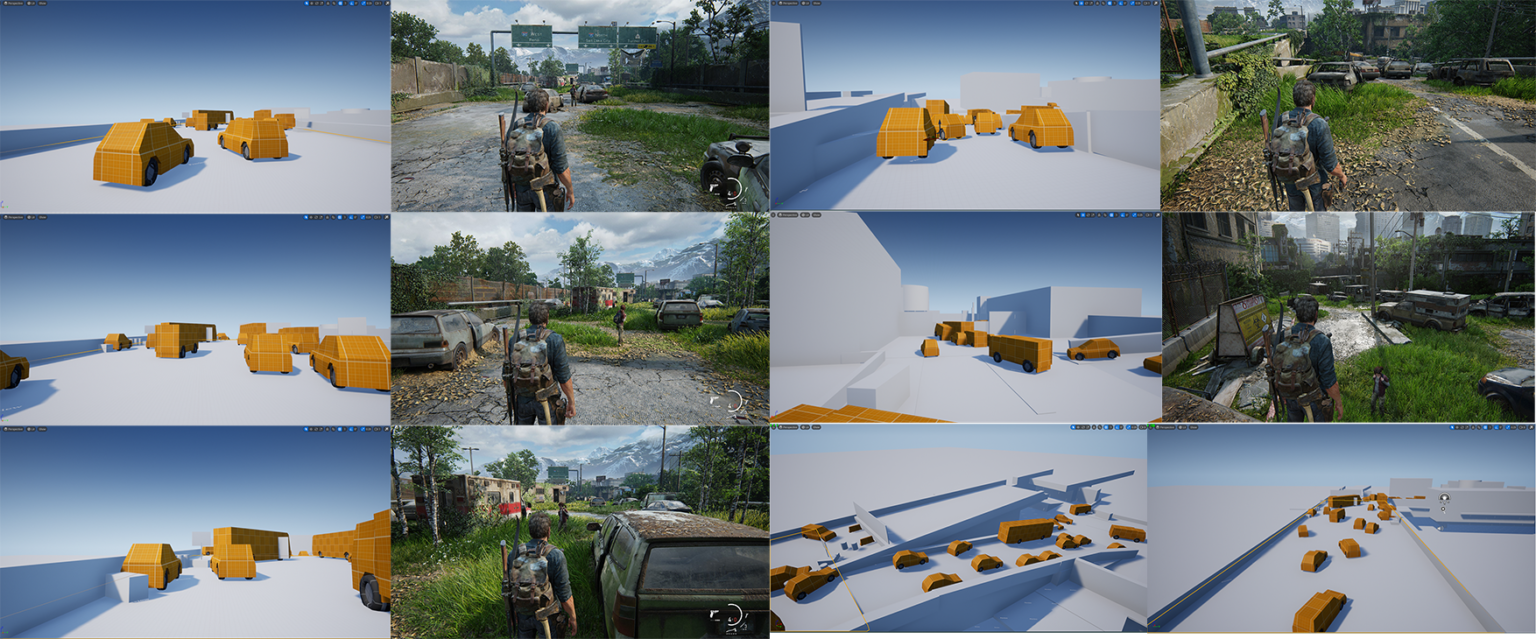
Made with Unreal Game Engine.

Case study Revers creation
original gameplay record
The second experiment of this week is an extension based on the ingredient “Eviscerate” from last week. Although during last week’s discussion time, I realized that using artworks as a case study and reconstructing them in the form of games or 3D models can provide me with a new method and learning approach, but I still believe that studying similar products can better help me with my creation. Therefore, I conducted a case study on a game this week and reconstructed its level design.
The game I have chosen is The Last of Us Part 1. It is a game with an excellent story and level design, using it as an example will definitely help me learn more about level design. In this part of the game, an environmental storytelling area has been set to illustrate how people’s attitudes towards the world changed after the outbreak of zombies. After the level starts, players need to move forward along the abandoned road. After a while, the designer places a motorhome horizontally in front of the player and use the colour difference between inside and outside to create a huge contrast in the game screen to attract players’ attention. To make players enter the motorhome and explore to understand the story happening inside, creating a sense of sadness and pity for the player. I believe that the feeling created based on environmental storytelling is an important part of the player experience and what excellent level design needs to achieve. Cars on the road are arranged to naturally guide players to the correct destination. The vehicles piled up at the entrance of the isolation zone when leaving the bridge are also designed to guide players’ vision inward in a shrinking form, forming a natural arrow pointing players towards the correct position.
Week4 - Cordiality
Research Question(Final Version I think ):
How might prioritising level design in game development, as the central core influencer of the other aspects of production (such as narrative, character development, and mechanics), act as an alternate means of enhancing the player’s immersive and interactive gameplay experience?
Reflection on all practice:
Now that I have completed three weeks of production, I have researched and learned about level design in different ways, centred around level design by thinking about the raw materials. At the same time, I am looking for different ways to respond to my research question. For instance, the scene I created in the third week based on the plot of the Harry Potter movie, and the case study conducted in the second week. Through these experiments, I can confirm that I have expanded my self’s knowledge. However, I cannot define whether I have expanded myself sufficiently; I can only say that I have tried many different experimental methods to answer my research question because I do not have enough time to create a real level. This is also my expectation for the production in the following week: to create a complete large-scale level that can tell a story.
Throughout the three-week experimental process, I only focused my production materials, media, and methods on the game production process, which I think is entirely reasonable because one of the research objectives is to explore how to make good-level design. Based on this goal, I should only focus on using methods in the game design process to conduct experiments. In the process of the experiment, I also carried out case study, which is a method that I will use in the research project. Through these cases, such as the oil painting in the second week and the game in the third week, I gained knowledge and used this knowledge as the driving force and foundation for the next creation to conduct experiments.
Adhering to the rationing constraints brought by the first few weeks of the DP2 experimental process is indeed challenging for me, especially in terms of time. For digital design, or my research direction of “level design”, strictly adhering to the allocation schedule will make me produce many works that seem meaningless from my perspective. One issue with time is that it is impossible to produce many works quickly in game design/ level design. I personally believe that there is a significant difference between design and artistic creation. Level design is more about reasonably arranging and disposing of all items in the level, thereby creating a good game experience. For example, I combined the four 120-minute sessions in the second week to create a relatively long large-scale desert level. This was initially just a 120-minute experiment, but as I started production, I found that I couldn’t complete this socalled level within the 120-minute limit. So I divided the level into four areas and then used these four 120-minute sessions to complete the construction of the entire level.
Although I am not accustomed to the allocation schedule, I can understand the creativity it contains through three weeks of creation. For instance, the work produced using 5-30 minutes can help me explore different directions in the level design process. For example, the experiment based on amalgamate conducted in the second week quickly built the exterior of a building in a simple and fast form, making sufficient preparation for the later more detailed design. And since my practice is carried out in the form of an iterative design cycle, simple works can achieve better quality and a higher degree of completion through subsequent production iterations.
Through the feedback obtained from the previous peer review, I realized that my current experiment has not fully covered my research question, and I still need to give an accurate game genre definition to my research question. This, indeed is something worth thinking about. The absence of an accurate game type would make the scope of exploration too broad and not focused enough, resulting in insufficient exploration. Also, since this is a game study, the best way to show the game and the best way to get the game experience is definitely to participate (the choice made in week 3), which I have yet to achieve. Therefore, based on these, I have made the following plan to facilitate my continued work.
In the remaining practice time, I will complete two experiments:
- Define the game type and viewpoint type of this research experiment through experimental verification.
- Produce a short level that allows the audience to participate, and try the environmental narrative techniques learned within it.
Camera Angle Test
Based on the feedback received from the silent demonstration to peers, some of the feedback on my research question made me realize that my research question needs some key themes. Interestingly, there was a theme in my previous research question. Here, the “theme” refers to the type of game for which the level design is being conducted and the type of game this project aims to create and study. However, after later iterations of the research question, this game type disappeared. Through this experiment, I want to determine what kind of game type, or control method, is more suitable for the research I am currently conducting.
Perspective, or camera angle, needs be observed in an actual situation to see if it achieves the desired effect. So this experiment chose two simple and playable game scenes (which can be seen as levels), and observed the environment of the controlled character from different camera perspectives. The observation results are used to determine the most suitable perspective for this research project.
Test Environment 1:
I chose the maze drawn in the first week for the first test. Based on the maze’s inherent “Play” characteristic of the maze, playing this maze from different perspectives will help determine which perspective is more suitable for telling the story to the player.
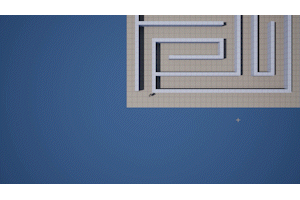

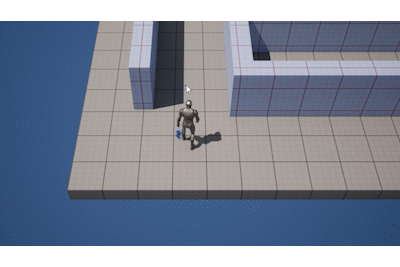
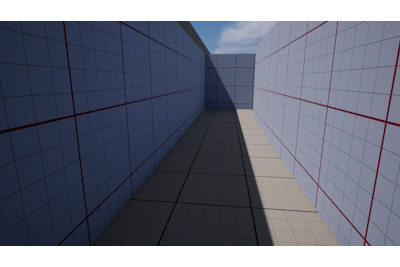
Made with Unreal Game Engine and Maya.
Test Environment 2:
I also selected a drawing from the first week for the second test environment. In my imagination, this scene might represent a rooftop situated in a desert environment, possibly in the Middle East. The rooftop is characterised by a central skylight and several terraces. This scene does not possess playability; it merely serves an aesthetic function and allows for movement.
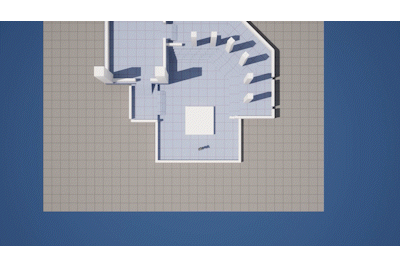
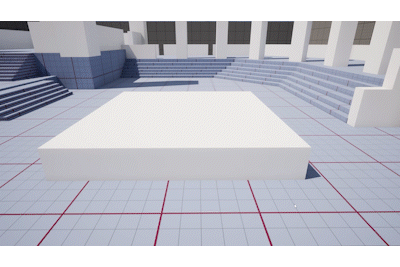
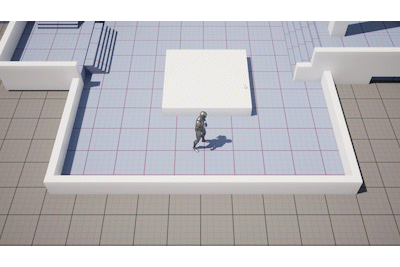
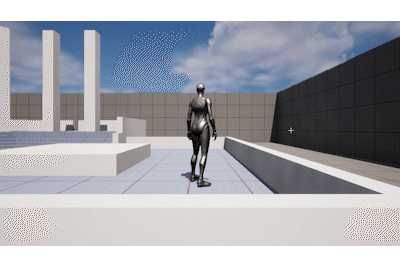
The testing was conducted from four camera perspectives: far top-down, close top-down, third person, and first-person.
Fat Top-Down View:
The inspiration for testing this perspective comes from the traditional process of interacting with a maze on paper. This view allows the player to observe the entire construction of the maze and all the designs as if playing on paper. Everything can be seen from a camera suspended in the sky. This kind of global observation camera perspective often appears in RTS games like “Warcraft 3” and “Starcraft 1, 2”. It provides the player with a better field of view to observe many game characters and better judge what is happening on the battlefield.

Close Top-Down View:
As this perspective is named, this is a top-down perspective where the camera position is relatively close to the character. This view will not be able to observe the entire maze and scene like far top-down view, but based on the camera angle, it can still see a lot of environments that should not be within its range. The game “Diablo” uses this kind of game perspective.

Third-Person View:
The third-person perspective places the player’s view behind the game character they control (initial position). The camera doesn’t have to be right behind the player, and the game character doesn’t have to be in the center of the camera. The factors determining the position of the camera and the character are related to the game’s theme and how the camera is handled. For example, in “The Last of Us”, the player is always in the lower left corner of the camera, leaving enough space for player to observe the environement.
This perspective allows players to view the game from an almost bystander’s perspective, but the player can still observe the actions and expressions of their characters. This helps establish a connection between the player and the character they are controlling. Under the third-person perspective, the player can observe a large area of the environment; but it will not make the player see the environment that should not be seen due to the camera or outside the character’s field of view.

First-Person View:
The first-person perspective directly represents the view seen by the eyes of the player’s controlled character. The first-person perspective has the best immersion because as a player, humans also observe the real world through their eyes in reality. Playing a first-person game is like the player are playing in the game world. Although the first-person perspective does not have a large range of views that can be observed compared to the third-person perspective, it can also better allow players to focus on the clues in the level environment. The game “Bioshock” is a classic example, achieving excellent environmental narrative effects under the first-person perspective.

Experiment Conclusion & Camera Perspective and Game Type Selection:
After using the drawing completed in the first week to built into a maze and environment in Maya and Unreal Engine, I tested the maze and rooftop with the four perspectives mentioned above. I first found that the two top-down perspectives would break the sense of immersion in the game or cause spoilers. This kind of “spoiler” is not the usual sense of revealing the plot in advance, but the player can observe the level/environment that should not be observed due to the camera’s perspective.
Take the maze map as an example; the far top-down camera allows players to see the entire maze directly. This makes the maze in the game no different from the maze the player plays on paper. By observing, players can easily find the correct path, thus losing the experience of being in a maze. The close top-down perspective is the same.
Because the camera can observe large areas, the player can always see things at the intersection or wall that they should not see under normal eye view, which makes the entire maze easier. Moreover, the camera is too far from the player’s character, the information in the environement will be too much, and the items in the scene will become smaller, making it not easy for the player to discover the information hidden in the environment.
So the choice of camera perspective can only be chosen from the first person and the third person. My final decision is to use the third person as the camera perspective of the entire research project and to determine the game type in the action-adventure game. This choice is because, in most cases, the third person can do what the first person can do and can convey emotional information to the player better through the character’s body movements. And compared to the top-down camera perspective, the third person does not let players get too much visual information; while it gets more information than the first person gets, it is in a just right position. The choice of the game type is because the third-person perspective is very suitable for this type of game, and there are many excellent story-driven games.